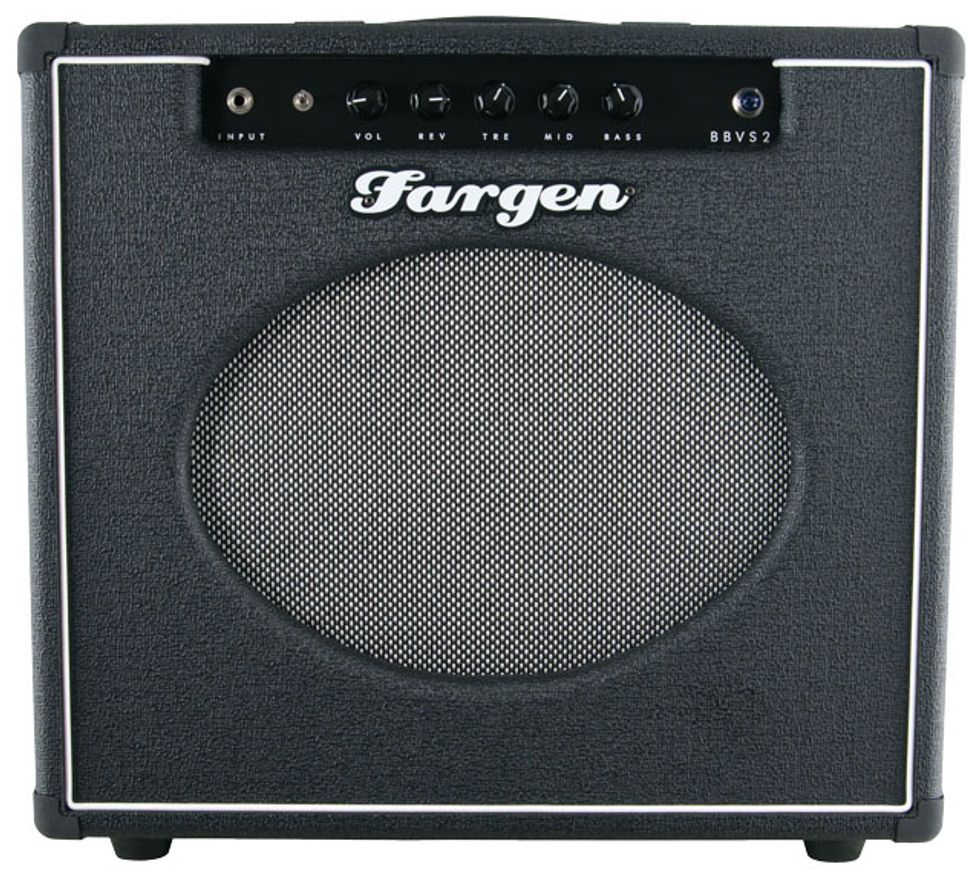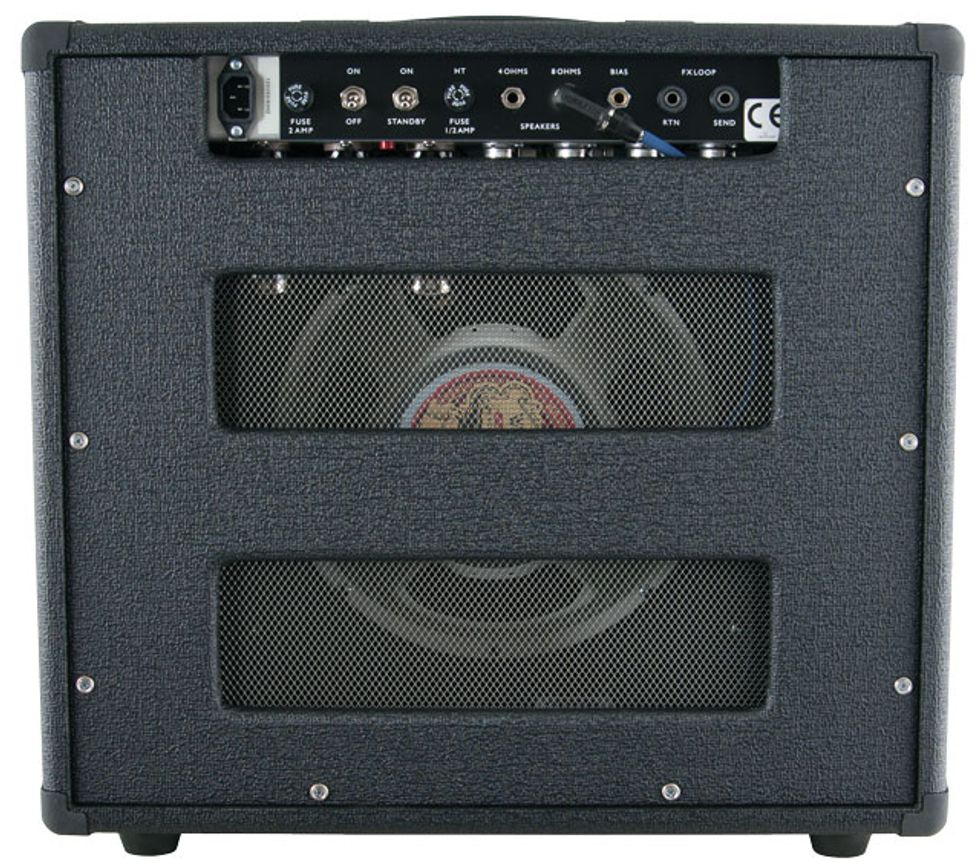We remember 1968 as one of the most pivotal years in our history. It was a time of great change, divided opinions, and fighting in the streets. I refer, of course, to the reaction when Fender rolled out the silverface Deluxe.
Many amp aficionados realize that silverface Fenders retained many blackface characteristics and components well into the ’70s. Yet many regard 1968’s newfangled silverfaces as symbols of CBS’s stranglehold on the company Leo built. Soon players were pining for those glorious blackfaces, even modifying their silverfaces to sound like them. Today’s boutique builders still regard blackfaces as some of the most inspirational amps ever as they seek to match or, dare I say, better those legendary tones.
Ben Fargen’s superb Marshall plexi and Vox AC clones are already minor legends in boutique circles. Meanwhile, his Blackbird VS2, as its name suggests, draws inspiration from Fender’s blackface era. Loaded with 6L6s, pushing 40 watts, and boasting a bright switch between the input and the controls, this amp has much in common with the rare Vibroverb. It’s an amazing platform for pedal-heavy rigs.
Outwardly Elsewhere
The Blackbird’s cosmetics don’t shout “Fender” (apart from the black color). The simple controls offers easy access to volume, reverb, treble, mid, and bass knobs. If you roll any tone control completely to the left, it’s off, and the amp won’t pass any signal. This means there’s a truly additive feel as you move each knob to the right, providing plenty of tonal variation.
A peek inside reveals clean, point-to-point wiring, Mercury Magnetics transformers, and other quality components mounted to a stout chassis. The back panel offers an effects loop and extension cab outs. Ultimately, the signal finds its way to a 12” Warehouse speaker. At 35 pounds, the Blackbird isn’t terribly heavy for a 40-watter.
Clear Overhead, Fire Below
It only takes a few minutes of playing to recognize the familiar glassy tones of Fender’s mid-’60s period. With every knob at 12 o’clock, I plugged in an SG Classic loaded with P-90s and banged out some barre chords. At this volume level the amp was tight and responsive with a little natural compression. The output perched on the verge of distortion, even when played hard. Single-note runs generated nice harmonics and sustain. Moving closer to the amp yielded more sustain without rolling over into feedback. Things definitively got distorted when I increased the volume to about 2 o’clock—sustained single notes crossed over into singing, musical feedback. This is arguably the amp’s sweet spot.
It’s also very stompbox-friendly at these settings. For fuzz, I tried a Tone Bender Mk II clone. This circuit can lack clarity with some amps, but that wasn’t the case with the Blackbird. I could even get a great rhythm sound with this high-gain pedal. Next I pushed the envelope with a Death By Audio Interstellar Overdriver at its most over-the-top setting, achieving tones bordering on sludge. But backing off a bit on the Overdriver settings produced heavy rock sounds that would have made Blue Cheer jealous. You might initially look to the Blackbird for clean tones, but the amp excels with a good fuzz or aggressive overdrive.
The Fargen also sounds great with subtler overdrive. Thanks to the amp’s pedal-friendly headroom, boosters tend to push the tubes and add grit more than they increase volume. My favorite setup was a stock DOD 250 Overdrive and a Telecaster loaded with single-coils. As I moved the guitar’s volume knob, the amp transitioned smoothly from clean to gritty, never sounding harsh.
The Blackbird’s bright switch is very subtle when using just a guitar and amp, but it makes a massive difference with distortion pedals. With the bright switch on, the Tone Bender added more of a fizzy, acid rock sound. Meanwhile, the DOD 250 became an even better lead boost, and a Boss Blues Driver went from serviceable to special-sounding. The bright switch can definitely expand your pedalboard’s palette.
Effective low-mids can be a challenge with many amps, but the Blackbird’s mid control let me dial in thick, defined tones with no woolliness. As with the vintage Fenders that inspired it, it’s easy to call up great tones with the Blackbird.
However, the reverb was almost too mellow for my tastes. Oh, it sounds fabulous— warm, rich and spacious. But when dimed it adds about as much depth as a vintage unit in the lower half of its range. No matter how hard I played, I couldn’t excite the springs, or introduce any snap. It’s excellent for light ambience, but surf rockers may need to dust off their old Fender outboard tanks.
Ratings
Pros: Simple to use. Almost impossible to get a bad sound. Fully captures the blackface spirit.
Cons: Could use a wetter reverb.
Tones:
Ease of Use:
Build/Design:
Value:
Street:
$2,250 (head) / $2,650 (combo)
fargenamps.com
No surprise that the Fargen sounds great in the studio. It’s also a stunner for small club shows. I sometimes play with the quirky Durham, N.C., pop group Organos, whose guitar parts range from delicate lines to slashing, Pixies-style leads. Paired with my trusty Jazzmaster, the Fargen sat beautifully in the mix, but was willing and able to stand out when it needed to. As with many open-back amps, the sound spread was excellent, filling the room.
The next night I sat in with psych-rock warriors Prisms for a set heavy with fuzz, delay, reverb, phase, flange, and just about everything in the time-based-effect playbook.
Through it all, the Blackbird remained focused and clear. I was most impressed by how well the Blackbird took repeat-percussion-style tremolo, which can lose its aggressive chop when used with a cranked, but less responsive, amp. Such issues don’t plague the Fargen.
The Verdict
In both studio and live settings the Blackbird delivered the goods. Amps of this quality have many admirers, but they can be expensive. But it’s worth noting that a ’67 Deluxe retailed for almost $300 in its day—almost $2,000 in today’s dollars. Meanwhile, a vintage Vibroverb in decent shape will set you back at least $4,000. I’d venture to say that considerably more care went into building the Fargen. This amp should sound and look great 50 years from now, just as many of our beloved blackfaces do today.









![Rig Rundown: Russian Circles’ Mike Sullivan [2025]](https://www.premierguitar.com/media-library/youtube.jpg?id=62303631&width=1245&height=700&quality=70&coordinates=0%2C0%2C0%2C0)

















